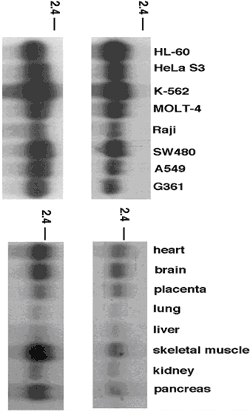 Expression of human PheRS α - and β-subunits.(a) Membranes containing mRNAs from human tissues (right) or malignant cell line (left) were probed with random primed cDNAs encoding α-(top) and β p-(bottom) subunits. |
Mammalian aaRSs, specifically PheRS, were found to be involved in human autoimmune diseases such as polyomyositis, dermatomyositis, and juvenile rheumatoid arthritis. Being identified as a human autoantigen these enzymes drive the autoimmune response. A novel human cDNA encoding mRNA preferentially expressed in a tumorigenic human acute-phase chronic myeloid leukemia (CML) cells have been detected. This cDNA proved to encode a polypeptide chain of catalytic α-subunit of human cytoplasmic PheRS. Knowledge of 3D-structure of T. therm. PheRS and its complex with tRNAPhe coupled with multiple sequence alignment evidence for the fact that binding and recognition modes of cognate tRNAPhe are different in prokaryotes and eukaryotes. This sharp biological distinction prompted us to investigate the structural basis of the superspecificity and the discrimination mechanism of human PheRS. |